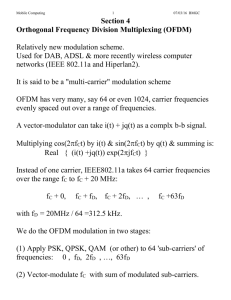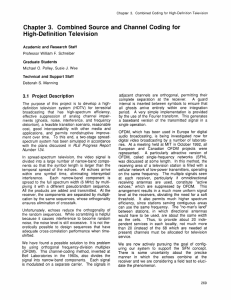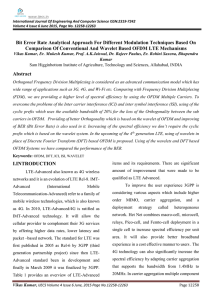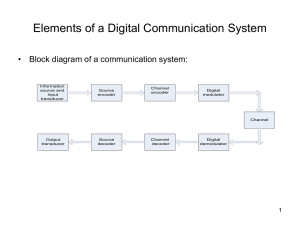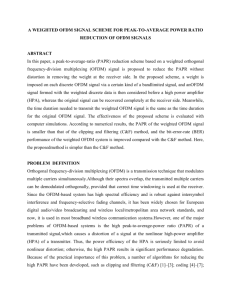www.ijecs.in International Journal Of Engineering And Computer Science ISSN:2319-7242
advertisement
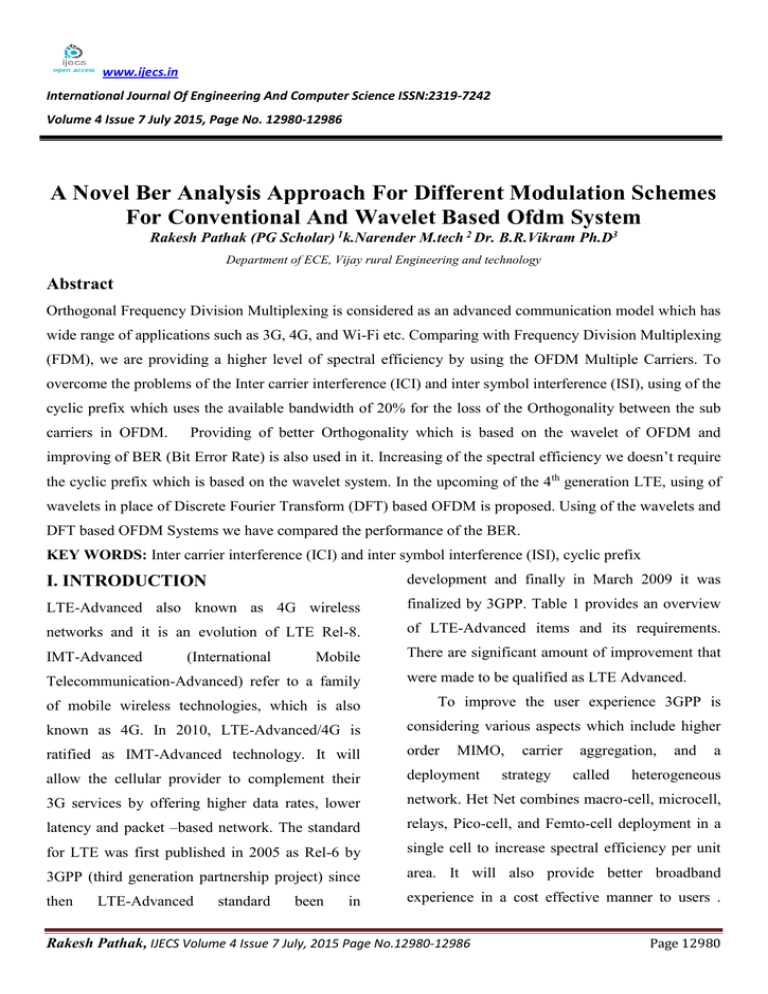
www.ijecs.in
International Journal Of Engineering And Computer Science ISSN:2319-7242
Volume 4 Issue 7 July 2015, Page No. 12980-12986
A Novel Ber Analysis Approach For Different Modulation Schemes
For Conventional And Wavelet Based Ofdm System
Rakesh Pathak (PG Scholar) 1k.Narender M.tech 2 Dr. B.R.Vikram Ph.D3
Department of ECE, Vijay rural Engineering and technology
Abstract
Orthogonal Frequency Division Multiplexing is considered as an advanced communication model which has
wide range of applications such as 3G, 4G, and Wi-Fi etc. Comparing with Frequency Division Multiplexing
(FDM), we are providing a higher level of spectral efficiency by using the OFDM Multiple Carriers. To
overcome the problems of the Inter carrier interference (ICI) and inter symbol interference (ISI), using of the
cyclic prefix which uses the available bandwidth of 20% for the loss of the Orthogonality between the sub
carriers in OFDM.
Providing of better Orthogonality which is based on the wavelet of OFDM and
improving of BER (Bit Error Rate) is also used in it. Increasing of the spectral efficiency we doesn’t require
the cyclic prefix which is based on the wavelet system. In the upcoming of the 4th generation LTE, using of
wavelets in place of Discrete Fourier Transform (DFT) based OFDM is proposed. Using of the wavelets and
DFT based OFDM Systems we have compared the performance of the BER.
KEY WORDS: Inter carrier interference (ICI) and inter symbol interference (ISI), cyclic prefix
I. INTRODUCTION
development and finally in March 2009 it was
LTE-Advanced also known as 4G wireless
finalized by 3GPP. Table 1 provides an overview
networks and it is an evolution of LTE Rel-8.
of LTE-Advanced items and its requirements.
IMT-Advanced
There are significant amount of improvement that
(International
Mobile
Telecommunication-Advanced) refer to a family
were made to be qualified as LTE Advanced.
of mobile wireless technologies, which is also
To improve the user experience 3GPP is
known as 4G. In 2010, LTE-Advanced/4G is
considering various aspects which include higher
ratified as IMT-Advanced technology. It will
order
allow the cellular provider to complement their
deployment
3G services by offering higher data rates, lower
network. Het Net combines macro-cell, microcell,
latency and packet –based network. The standard
relays, Pico-cell, and Femto-cell deployment in a
for LTE was first published in 2005 as Rel-6 by
single cell to increase spectral efficiency per unit
3GPP (third generation partnership project) since
area. It will also provide better broadband
then
experience in a cost effective manner to users .
LTE-Advanced
standard
been
in
MIMO,
Rakesh Pathak, IJECS Volume 4 Issue 7 July, 2015 Page No.12980-12986
carrier
strategy
aggregation,
called
and
a
heterogeneous
Page 12980
The 4G technology can also significantly increase
their practical deployments. The combination of
the spectral efficiency by adapting carrier
High Speed Downlink Packet Access (HSDPA)
aggregation that supports the bandwidth from
and the subsequent addition of an Enhanced
1.4MHz to 20MHz. In carrier aggregation
Dedicated Channel, also known as High Speed
multiple component carriers can be jointly used
Uplink Packet Access (HSUPA), led to the
for transmission to/from user equipment. It is
development of the technology referred to as High
done such a way that it will be compatible with
Speed Packet Access (HSPA) or, more informally,
the previous releases of LTE.
3.5G.
The fourth generation (4G) of wireless cellular
II. MOTIVATION
systems has been a topic of interest for quite a
Motivated by the increasing demand for mobile
long time, probably since the formal definition of
broadband services with higher data rates and
third generation (3G) systems was officially
Quality of Service (QoS), 3GPP started working
completed
International
on two parallel projects, Long Term Evolution
Telecommunications Union Radio communication
(LTE) and System Architecture Evolution (SAE),
Sector (ITU-R) in 1997. A set of requirements
which are intended to define both the radio access
was specified by the ITU-R regarding minimum
network (RAN) and the network core of the
peak user data rates in different environments
system, and are included in 3GPP Release 8.
through what is known as the International Mobile
LTE/SAE, also known as the Evolved Packet
Telecommunications 2000 project (IMT-2000).
System (EPS), represents a radical step forward
The requirements included 2048 kbps for an
for the wireless industry that aims to provide a
indoor office, 384 kbps for outdoor to indoor
highly efficient, low-latency, packet-optimized,
pedestrian environments, 144 kbps for vehicular
and more secure service. The main radio access
connections,
design parameters of this new system include
by
and
the
9.6
kbps
for
satellite
connections.
With
collaboration
OFDM
the
target
entity
telecommunications
of
among
associations,
creating
(Orthogonal
Frequency
Division
a
Multiplexing) waveforms in order to avoid the
different
inter-symbol interference that typically limits the
the
3rd
performance of high-speed systems, and MIMO
Generation Partnership Project (3GPP) was
(Multiple-Input Multiple-Output) techniques to
established in 1998. It started working on the
boost the data rates. At the network layer, an all-
radio, core network, and service architecture of a
IP flat architecture supporting QoS has been
globally applicable 3G technology specification.
defined.
Even though 3G data rates were already real in
III. PROPOSED METHOD
theory, initial systems like Universal Mobile
Telecommunications System (UMTS) did not
immediately meet the IMT- 2000 requirements in
In this paper we have compared the
performance of wavelets based OFDM system
with performance of conventional OFDM system
Rakesh Pathak, IJECS Volume 4 Issue 7 July, 2015 Page No.12980-12986
Page 12981
for different LTE modulation techniques. For
OFDM system. The proposed wavelet based
wavelet based system we have used daubechies2
OFDM design is presented and then the
and haar wavelets. Additive White Gaussian
performance evaluation and the results obtained
Noise (AWGN) channel is used for transmission.
from the simulation are discussed and Conclusion
The paper is organized as first of all the
is summarized.
conventional OFDM system and wavelet based
Data Encoding
Modulation
IFFT
Adding CP
Noise
Data Decoding
Demodulation
FFT
Pilot
Removing CP
Synchronization
Figure 1: DFT based OFDM transmitter and receiver
A) Conventional Ofdm System
Orthogonality.
For typical OFDM system sinusoids
For LTE, in the downlink information of
of DFT type associate orthogonal basis perform
various users is multiplexed in frequency domain
set. In DFT the remodel correlates its signaling
and access technique is termed Orthogonal
with every of curving basis perform , here
Frequency Division Multiple Access (OFDMA) .
orthogonal basis functions are the subcarriers
within the transmission of the LTE access
utilized in OFDM. At the receiver the signals are
technique used is Single Carrier-Frequency
combined to get the information transmitted.
Division Multiple Access (SC-FDMA). High Peak
much, quick Fourier remodel (FFT) and Inverse
Average Power quantitative relation (PAPR)
quick Fourier remodel (IFFT) are used for the
happens because of random constructive addition
implementation of the OFDM system as a result
of subcarriers and leads to spectrum spreading of
of less range of computations needed in FFT and
signal resulting in adjacent channel interference.
IFFT. Multiple replicas of the signal are received
So
at the receiver finish attributable to the time
compression purpose electronic equipment got to
dispersive nature of the channel, thus frequency
be wont to overcome this downside. These
selective fading results and to scale back this
strategies are often implemented at base station
interference guard interval is used that is termed
(BS), however ar high-priced to implement at user
cyclic prefix. Cyclic prefix is copy of the some
instrumentality (UE).
power
linearization
techniques
and
fraction of image finish. As long because the
Thus LTE uses SCFDMA with cyclic
channels delay unfold remains among the limit of
prefix on transmission, which is able to end in
the cyclic prefix there would not be any loss in
reduction of PAPR attributable to the presence of
Rakesh Pathak, IJECS Volume 4 Issue 7 July, 2015 Page No.12980-12986
Page 12982
single carrier. Due to single carrier modulation
with quality of Fourier rework of O[N log2 N] .
impact of Inter-Services Intelligence are high in
Ripple primarily based OFDM is simple and also
uplink and to beat from its impact low
the DFT primarily based OFDM is complicated.
complexness equalizer are needed however SC-
Wavelet based OFDM is versatile further and
FDMA isn't sensitive to frequency offset and
since higher Orthogonality is provided by it,
propagation.
there's no a need of cyclic prefixing in ripple
B) Wavelet Based Ofdm System
primarily based OFDM that is needed in DFT
Wavelet rework could be a tool for
based OFDM to take care of Orthogonality
analysis of the signal in time and frequency
therefore ripple based system is a lot of
domain together. it's a multi resolution analysis
information measure economical as compared
mechanism
with the DFT based OFDM.
wherever
signal
is
rotten
into
completely different frequency elements for the
In distinct ripple rework (DWT), signal
analysis with explicit resolution matching to scale
presented
. Using any explicit sort of ripple filter the system
different filters and can be decomposed into low
will be designed in line with the necessity and
pass and high pass bands through the filters.
additionally the multi resolution signal will be
throughout decomposition the high pass filter can
generated by the utilization of wavelets. By the
take away the frequencies below 1/2 the best
utilization of varying ripple filter, one will style
frequency and low pass filter can take away
waveforms
frequencies that area unit on top of 1/2 the highest
with
selectable
time/frequency
partitioning for multi user application .
Wavelets possess higher Orthogonality
can
experience
many
completely
frequency. The decomposition halves the time
resolution as a result of 1/2 the samples area unit
and have localization each in time and frequency
accustomed
characterize
the
signal
equally
domain. Because of good Orthogonality wavelets
frequency resolution
area unit capable of reducing the power of the
decomposition method are perennial once more
international intelligence agency and ICI, which
for getting the ripple coefficients of needed level.
ends from loss of Orthogonality. To cut back
2 forms of coefficients area unit obtained through
international intelligence agency and ICI in
process, 1st ones area unit called elaborated
typical OFDM system use of cyclic prefix is there,
coefficients obtained through high pass filter and
that uses 2 hundredth of available information
second ones area unit referred to as coarse
measure, therefore leads to information measure
approximations obtained through low pass filter
unskillfulness however this cyclic prefix isn't
connected with scaling method. After passing the
needed in ripple primarily based OFDM system.
info through filters the destruction method are
quality also can be reduced by victimization ripple
performed. the entire procedure can continue till
transform as compared with the Fourier rework as
the required level is obtained.
are doubled and this
a result of in wavelet quality is O[N] as compared
Rakesh Pathak, IJECS Volume 4 Issue 7 July, 2015 Page No.12980-12986
Page 12983
C. PROPOSED WAVELET BASED OFDM
orthogonality to the subcarriers. IDWT will
DESIGN
convert time domain signal to the frequency
In this proposed model we are using IDWT
domain. After passing through the channel on the
and DWT at the place of IDFT and DFT. AWGN
signal DWT will be performed and then pilot
channel is used for transmission and cyclic
synchronization where the inserted pilots at the
prefixing is not used. Here first of all conventional
transmitter are removed then the demodulation is
encoding is done followed by interleaving then
done.
data is converted to decimal form and modulation
Demodulated data is converted to binary form and
is done next. After modulation the pilot insertion
the de-interleaved and decoded to obtain the
and sub carrier mapping is done then comes the
original data transmitted.
IDWT
of
the
data,
which
provides
Data Encoding
the
Interleaving
IDWT
Carrier Mapping
Modulation
Pilot Insertion
AWGN Channel
FFT
Demapping
Data Decoding
Deinterleaving
Pilot Synchronization
Demodulation
Figure 2: Wavelet based proposed OFDM system design
IV. SIMULATION RESULTS
Rakesh Pathak, IJECS Volume 4 Issue 7 July, 2015 Page No.12980-12986
Page 12984
0
0
10
10
original-128
CF-1.6-128
CF-1.2-128
CF-0.4-128
WEIGHTERD-128
original-256
CF-1.6-256
CF-1.2-256
CF-0.4-256
WEIGHTERD-256
original-512
CF-1.6-512
CF-1.2-512
CF-0.4-512
WEIGHTERD-512
BER in dB
Analytic
C&F
proposed
-1
10
0
5
10
15
-1
20
10
1
2
3
4
5
6
7
8
9
10
EbNo
Figure 1: BER performance of wavelets and DFT
based
OFDM
system
using
QPSK modulation.
Figure 3: BER performance of wavelets and
DFT
based
OFDM
system
using
64-
QAM modulation.
0
10
original-128
CF-1.6
CF-1.2
CF-0.8
proposed
V. CONCLUSION
In this paper we have a tendency to analyzed the
performance of rippling primarily {based} OFDM
system and compared it with the performance of
DFT based OFDM system. From the performance
-1
10
curve we've determined that the BER curves
obtained from rippling primarily {based} OFDM
area unit higher than that of DFT based OFDM.
0
5
10
15
we have a tendency to used 3 modulation
20
techniques for implementation that area unit
Figure 2: BER performance of wavelets and DFT
based
OFDM
QAM modulation.
system
using
16-
QPSK, 16QAM and 64QAM, that area unit
utilized in LTE. In rippling based mostly OFDM
differing kinds of filters are often used with the
assistance of various wavelets offered. we've used
daubechies2 and haar wavelets, each offer their
best performances at totally different intervals of
SNR.
VI. REFERENCES
Rakesh Pathak, IJECS Volume 4 Issue 7 July, 2015 Page No.12980-12986
Page 12985
1]Alan
L.,(May.1997):“Wavelet
packet
modulation
for
orthogonally
multiplexed
communication”, IEEE transaction on signal
processing, vol. 45, no. 5, pp. 1336-1339.
[2]Antony J., Petri M., (Mar.2005):“Wavelet
packet modulation for wireless communication”,
Wireless communication & mobile computing
journal, vol. 5, no. 2, pp. 1-18.
[3] Bauml R.W., Fischer R.F.H., Huber J.B., (Oct
1996): “Reducing the peak to- average power ratio
of multicarrier modulation by selected mapping,”
Electron. Lett., vol. 32, no. 22, pp. 2056–2057.
[4]Broughton S. A,, Bryan K., (Jan.2009):“
Discrete Fourier analysis and wavelets”. New
Jersey, John Wiley.
[5]C.B.John
A.,
(May.1990):“Multicarrier
modulation for data transmission: an idea whose
time has come”, IEEE Communications magazine,
vol. 28, no. 5, pp. 5-14.
[6]Eiji
O.,
Yasunori
I.,
Tetsushi
I.,
(Oct.2003):“Multimode
transmission
using
wavelet packet modulation and OFDM”, IEEE
vehicular technology conference, vol. 3, pp. 14581462.
[7]F.A. Ian., M.G. David, Chavarria R. Elias,
(Dec.2010):“The evolution to 4G cellular systems:
LTE-advanced”,
Physical
communication,
Elsevier, vol. 3, no. 4, pp. 217-244.
[8] Huang X., Lu J., Zheng J., Letaief K.B., Gu J.,
(Nov.2004):
“Companding transform for
reduction in peak-to-average power ratio of
OFDM signals,” IEEE Trans. Wireless Comuun.,
vol. 3, no. 6, pp. 2030–2039.
[9] Jiang T.,Wu Y.,(Jun 2008): “An overview:
Peak-to-average power ratio re-duction techniques
for OFDM signals,” IEEE Trans. Broadcast., vol.
54, no. 2, pp. 257–268.
[10]Jung C. See., Ho L. Moon., Yong.P. Ju.,
(Jun.1997):“A high speed VLSI architecture of
discrete wavelet transform for MPEG-4”, IEEE
transaction consumer electron, vol. 43, no. 3, pp.
623-627.
[11]Jun L., Thiang T. Tjeng., Adachi F., Li.H.
Cheng., (Jul. 2000):“BER performance of OFDMMDPSK system in frequency selective rician
fading and diversity reception” IEEE Transactions
on Vehicular Technology, vol. 49, no. 4, pp.
1216-1225.
[12]Hasan K. Abbas., A.M. Waleed., Saad N.,
(Mar.2010):“The performance of multiwavelets
based OFDM system under different channel
conditions”, Digital signal processing, Elsevier,
vol. 20, no. 2, pp. 472- 482.
[13]Kumar
G.
Mahesh.,
Tiwari
S.,
(Apr.2013):“Performance
evaluation
of
conventional and wavelet based OFDM system”,
International journal of electronics and
communications, Elsevier, vol. 67, no. 4, pp. 348354.
[14]Kumar
L.
Madan.,
Homayoun
N.,(May.2006):“A review of wavelets for digital
wireless communication”, Wireless personal
communications, Kluwer academic publishersPlenum publishers, vol. 37, no. 3-4, pp. 387-420.
[15]Louis L., Michael P., (Jan.2001):“The
principle of OFDM” RF signal processing,
http://www.rfdesign.com, pp. 30-48.
[16]Mika R., Olav T., (Oct.2010):“LTE, the radio
technology path toward 4G”, Computer
communications, Elsevier, vol. 33, no. 16, pp.
1894-1906.
[17] Paterson K.G., Tarokh V., (Sep 2000): “On
the existence and construction of good codes with
low peak-to-average power ratios,” IEEE Trans.
Inf. Theory, vol. 46, no. 6, pp. 1974–1987.
[18]Volkan K., Oguz K., (Apr.2009):“Alamouti
coded wavelet based OFDM for multipath fading
channels”, IEEE Wireless telecommunications
symposium, pp.1-5.
[19] Wang Y.C., Luo Z.Q., ( Jan. 2011):
“Optimized iterative clipping and filtering for
PAPR reduction of OFDM signals,” IEEE Trans.
Commun., vol. 59, no. 1, pp. 33–37.
[20]Werner K., Gotz P., U. Jorn, Z Georg,
(Jul.2000)“A comparison of various MCM
schemes”, 5th International OFDM-workshop,
Hamburg, Germany, pp. 20-1 – 20-5.
Rakesh Pathak, IJECS Volume 4 Issue 7 July, 2015 Page No.12980-12986
Page 12986
